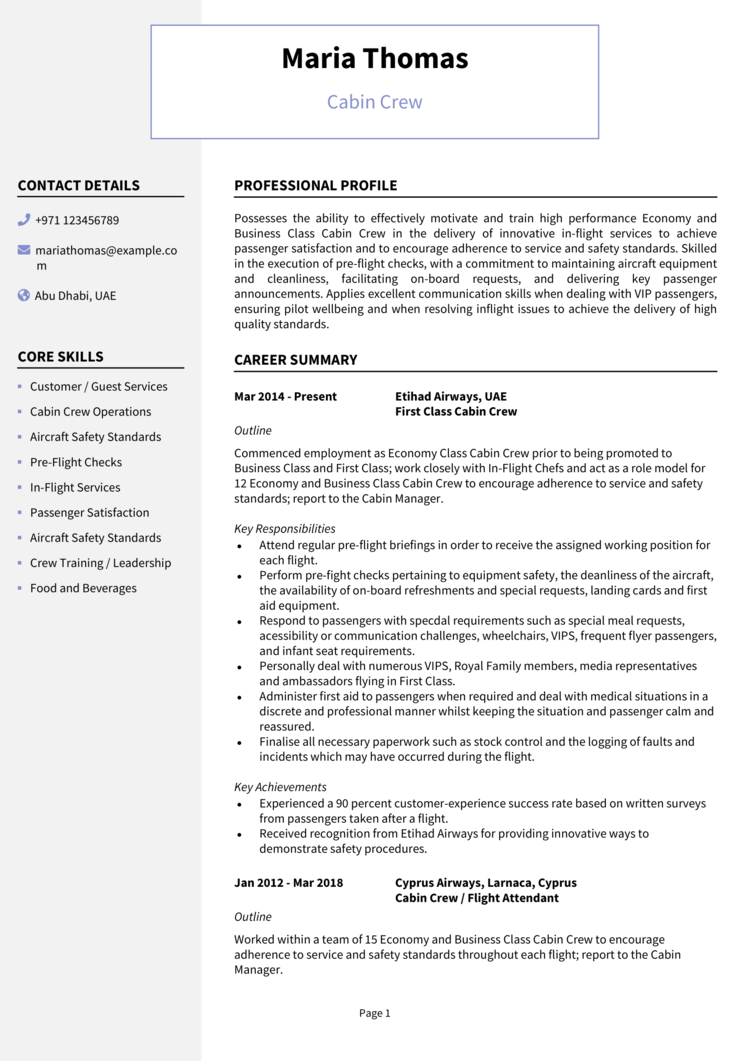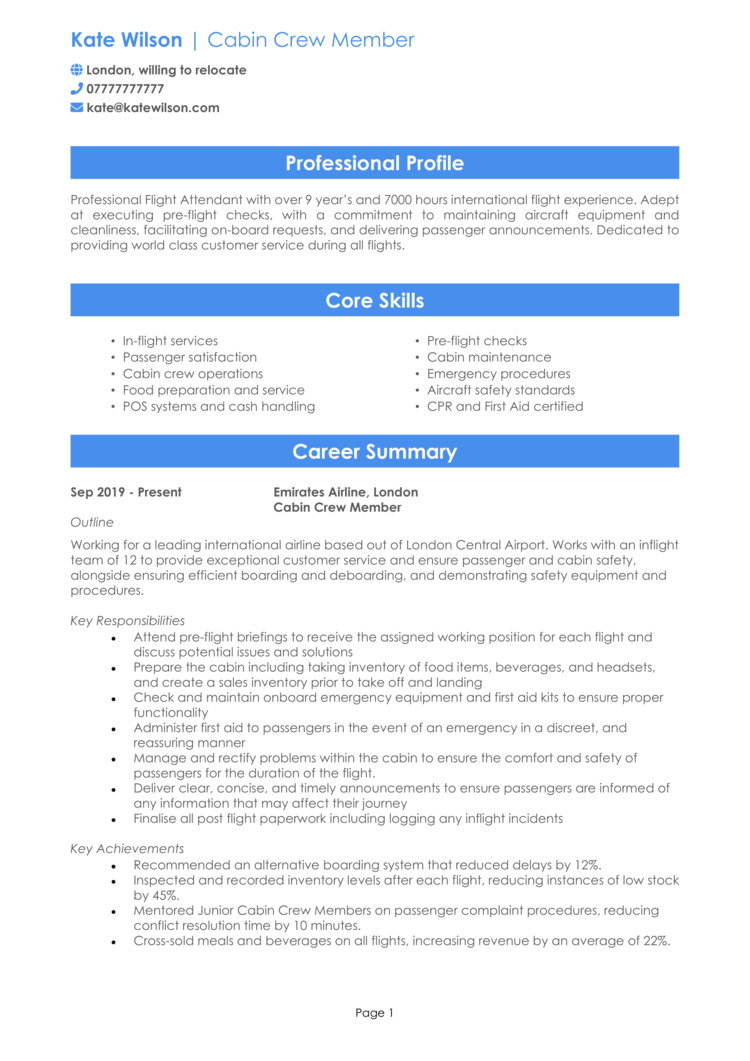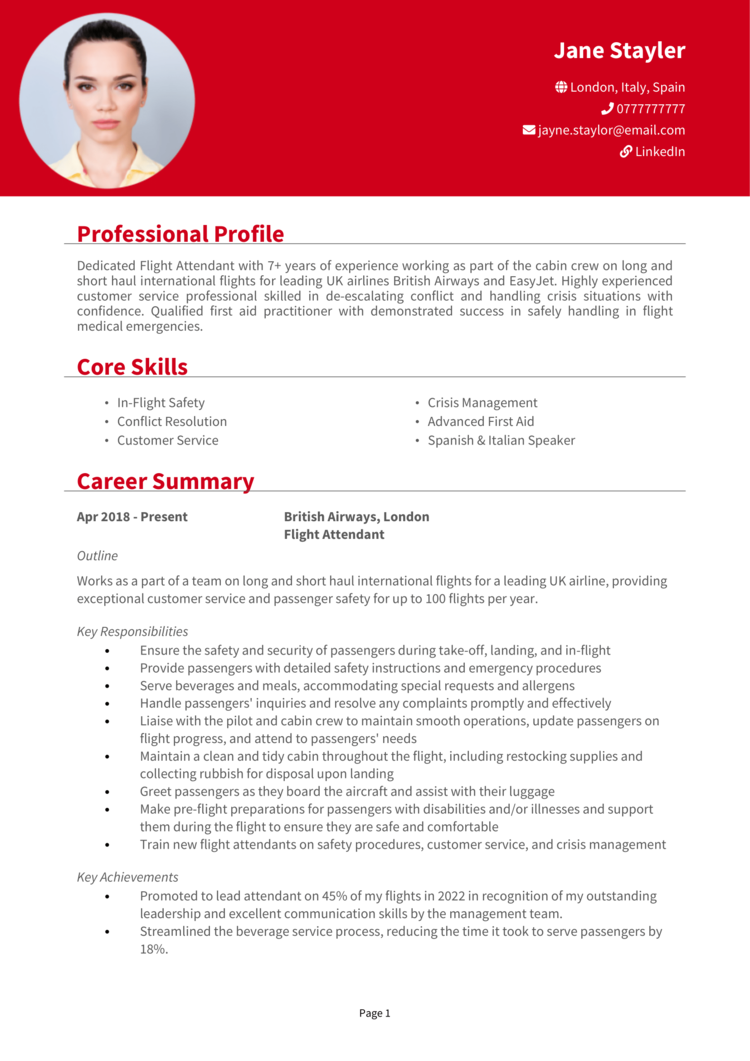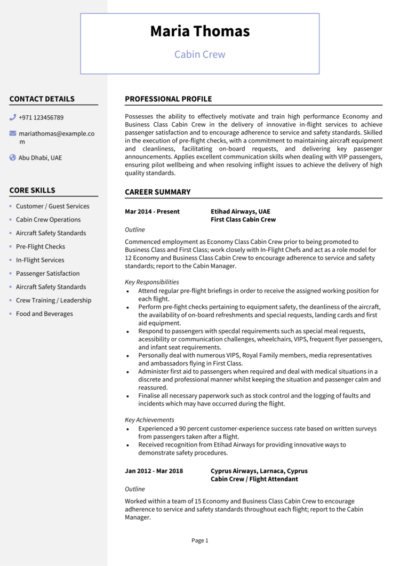As a cabin crew member, you’re part safety expert, part customer service pro, and part crisis manager – often all within the same flight.
But before you can glide through the cabin with confidence, you need to land the job first. This guide and its Cabin Crew CV examples will show you how to write a cabin crew CV that highlights your skills, experience, and ability to deliver exceptional service at 35,000 feet.
Cabin Crew CV example

Emirates Cabin Crew CV example

Flight Attendant CV example

How to write your Cabin Crew CV
Learn how to create your own interview-winning Cabin Crew CV with this simple step-by-step guide.
Your CV should be like a pre-flight briefing – concise, informative, and ideally not something hiring managers want to tune out halfway through.
To help you secure your ideal role, we’ll cover everything from CV structure to highlighting your customer service skills and aviation experience. By the time you’re done, your CV will be ready for takeoff.
Cabin Crew CV structure


Airlines receive thousands of applications, so a clear and structured CV helps recruiters quickly assess whether you meet their criteria. When writing a CV, every relevant piece of information needs to be coherently organised into a navigable layout, so recruiters don’t struggle to find what makes you such a good candidate.
Here’s the structure to follow:
- Name and contact details – Ensure personal details are easy to find, just like a well-placed life jacket. Keep them right at the top of your CV, with an optional photo.
- Profile – A strong introduction that highlights your hospitality, safety training, and ability to handle in-flight situations.
- Core skills – Provide a snapshot of your most relevant abilities, such as passenger care, conflict resolution, and safety procedures.
- Work experience – Detail your previous roles in reverse chronological order, focusing on responsibilities and achievements.
- Education – List any relevant qualifications, starting with the most recent.
- Additional info – Optionally mention language skills, hobbies, or customer service awards.
Cabin Crew CV format


A sleek, well-organised CV format mirrors the precision and professionalism needed for a cabin crew role – so make sure yours takes off smoothly. If recruiters have to search through formatting mistakes for key details, they might assume your approach to organisation isn’t quite first-class.
Make use of these formatting tips:
- Bullet points – Keep sentences concise and impactful, using bullet points to organise responsibilities.
- Divide sections – Use clear headings to make navigation simple for busy airline recruiters.
- Use a clear and readable font – Along with an appropriate colour scheme, ensure your font is easy for the recruiter to read
- No more than 2 pages – Stick to a two-page length limit to highlight your key achievements without unnecessary extras.
How to create a Cabin Crew CV profile


Your CV profile is your chance to make a strong first impression – just like a confident, friendly welcome when passengers step on board. Its overall aim is to convince recruiters that hiring you would benefit them – so touch upon the key aspects they want to see in a new employee.
Cabin Crew CV profile examples
Profile 1
Customer-focused Cabin Crew Member with three years of experience ensuring passenger safety and delivering exceptional in-flight service. Skilled in emergency procedures, conflict resolution, and providing personalised customer care in high-pressure environments. Adept at handling international flights, managing cultural differences, and maintaining professionalism at all times. Passionate about creating a comfortable and enjoyable travel experience for passengers.
Profile 2
Attentive and well-presented Cabin Crew Member with two years of experience working on both short-haul and long-haul flights. Proficient in safety demonstrations, first aid, and food and beverage service. Strong ability to remain calm under pressure while handling passenger requests and resolving issues efficiently. Committed to providing a safe, welcoming, and seamless journey for all travellers.
Profile 3
Experienced Cabin Crew Member with over five years of expertise in the aviation industry, specialising in premium-class service and VIP passenger care. Skilled in delivering exceptional hospitality, coordinating in-flight operations, and ensuring strict adherence to airline safety protocols. Proficient in multilingual communication, enhancing the travel experience for international customers. Dedicated to upholding the highest standards of service and safety.
What to include in your Cabin Crew CV profile
To make an impact, include:
- Your customer service experience – Airlines prioritise candidates who can provide outstanding hospitality.
- Safety training and awareness – Highlight your ability to follow strict aviation regulations and emergency procedures.
- Adaptability and resilience – Cabin crew members must handle unpredictable situations calmly and professionally.
- Languages and communication skills – If you’re multilingual, mention it – it’s a major asset in aviation.
- Teamwork and problem-solving – Show that you can work seamlessly with colleagues to ensure a smooth flight.
Core skills section


A core skills section helps recruiters quickly assess whether you’re a good fit for the role. The best applications are tailored to the specific airline and job description, ensuring that your CV skills align with what they’re looking for.
For example, if the airline prioritises VIP service, focus on high-end hospitality. If they emphasise safety procedures, highlight your ability to manage emergencies and passenger welfare.
Most valuable skills for a Cabin Crew CV
- Passenger Safety Procedures – Ensuring compliance with safety protocols, including emergency evacuations and first aid response.
- In-Flight Service Delivery – Providing high-quality food, beverage, and duty-free sales service to passengers.
- Emergency Response Training – Handling medical emergencies, fire outbreaks, and security threats during flights.
- Customer Assistance – Addressing passenger inquiries, concerns, and special requests to enhance the travel experience.
- Pre-Flight Checks – Inspecting cabin equipment, safety gear, and cleanliness before departure.
- Crisis Management – Remaining calm and effective in high-pressure situations, including turbulence and flight disruptions.
- Cultural Awareness and Sensitivity – Interacting with passengers from diverse backgrounds with professionalism and respect.
- Cabin Announcements – Delivering clear and engaging safety demonstrations and in-flight announcements.
- Team Collaboration – Working closely with pilots and fellow crew members to ensure seamless flight operations.
- Regulatory Compliance – Adhering to aviation industry regulations, airline policies, and international safety standards.
Work experience section


Your work experience section is your opportunity to show how you provided exceptional service, handled in-flight challenges, and contributed to a safe and enjoyable journey for passengers in practical settings.
List your roles in reverse chronological order, ensuring each entry focuses on your ability to work under pressure, assist passengers, and maintain high safety standards. If you don’t have previous cabin crew experience, that’s fine: emphasise transferable skills from hospitality, customer service, or security roles.
How to present past roles on a Cabin Crew CV

- Outline – Introduce the airline, the types of flights you worked on, and your role in the cabin crew team.
- Responsibilities – List your key tasks, such as passenger assistance, emergency procedures, and onboard service. Use action words like “assisted”, “ensured”, and “coordinated”.
- Achievements – Demonstrate tangible impact, such as high passenger satisfaction scores, commendations from senior staff, or successfully managing emergency situations.
Example jobs for Cabin Crew
Cabin Crew | SkyJet Airways
Outline
Provided outstanding in-flight service and ensured passenger safety on international routes, maintaining high standards of hospitality and professionalism.
Responsibilities
- Conducted safety demonstrations and ensured passengers understood emergency procedures.
- Delivered food, drinks, and duty-free sales, ensuring efficient service and customer satisfaction.
- Responded to passenger queries and requests, handling complaints and conflicts with professionalism.
- Assisted in first aid situations, providing medical support when required.
- Collaborated with the flight deck crew to ensure smooth takeoff, in-flight operations, and landing.
Achievements
- Achieved a 98 percent passenger satisfaction rating through attentive service.
- Handled an in-flight medical emergency efficiently, ensuring passenger safety and comfort.
- Recognised by senior staff for excellent teamwork and problem-solving skills.
Cabin Crew | Global Air
Outline
Ensured passenger comfort and safety on domestic and long-haul flights, providing excellent customer service and handling in-flight operations.
Responsibilities
- Performed pre-flight checks and assisted in cabin preparation before takeoff.
- Welcomed passengers onboard and provided assistance with seating and luggage storage.
- Ensured compliance with airline regulations, monitoring cabin conditions throughout flights.
- Handled special requests, including meal preferences and assistance for passengers with reduced mobility.
- Participated in emergency drills and provided first aid when required.
Achievements
- Received a commendation for professionalism and handling difficult passenger situations effectively.
- Increased duty-free sales by 15 percent through engaging product recommendations.
- Maintained an excellent attendance record and was promoted to senior crew member within two years.
Cabin Crew | EliteAirways
Outline
Delivered exceptional first-class service on premium international flights, ensuring an exclusive and comfortable experience for high-value customers.
Responsibilities
- Provided personalised hospitality to first-class and VIP passengers, catering to their specific preferences.
- Ensured seamless coordination of in-flight meal services, working closely with catering teams.
- Handled multilingual communication to assist international travellers effectively.
- Managed emergency situations, including medical incidents and evacuation procedures.
- Maintained detailed reports on in-flight incidents and service feedback.
Achievements
- Recognised for delivering first-class service, earning multiple positive passenger testimonials.
- Played a key role in improving premium-class customer retention rates by enhancing service standards.
- Successfully trained new recruits on safety procedures and in-flight service etiquette.
Education section


While many airlines provide their own training, listing your education history still adds credibility to your application. If you’ve completed cabin crew training, first aid courses, a degree, customer service diplomas, make sure to include them.
Top qualifications to showcase on a Cabin Crew CV
- Cabin Crew Attestation (CCA) – A key qualification for working with European airlines.
- Customer Service NVQ or Diploma – Useful for demonstrating your hospitality skills.
- First Aid and CPR Certification – Important for handling medical emergencies on board.
- Foreign Language Proficiency Certification – A major advantage in international aviation roles.
- Aviation Security Training – Demonstrates your understanding of safety and security protocols.





